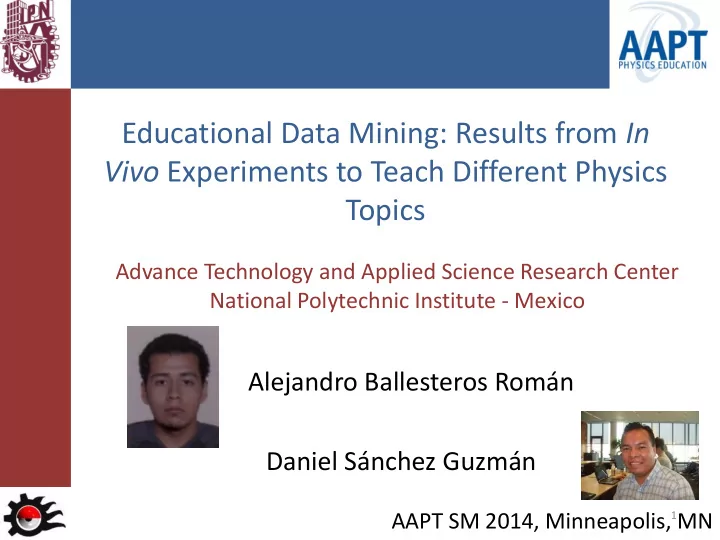

Educational Data Mining: Results from In Vivo Experiments to Teach Different Physics Topics Advance Technology and Applied Science Research Center National Polytechnic Institute - Mexico Alejandro Ballesteros Román Daniel Sánchez Guzmán AAPT SM 2014, Minneapolis, MN 1
Introduction Educational Data Mining (EDM) uses different algorithms for analyzing response and behavior in the teaching-learning process for obtaining useful patterns. These algorithms let to analyze and classify students' behavior or state of knowledge from different concepts. 2
Introduction Most of these algorithms have not been tested in Physics Education Research. This work presents the results obtained from applying algorithms used by EDM for teaching different physics concepts applied to in-vivo experiments. EDM Data sets* non-Physics Physics Total 67 27 94 71% 29% 100% * Pittsburgh Science of Learning Center (PSLC - CMU). Data Shop Public Data Sets. 3 https://pslcdatashop.web.cmu.edu/index.jsp?datasets=public
How Educational Data Mining works? 4
Implementation • EDM algorithms (Tree Decision Making, C4.5); were applied with N = 395 students. • Level: High-school students. • Topic: Electric Circuits and Ohm’s Law. • Multiple choice questions: 6 (Academy design, aprox. Electric Circuits Concept Evaluation - ECCE). 5
Results Q3 Q6 Q5 Q4 Q2 Q1 * Did not answer. 6
Results Q3 What does this mean? Q6 Q5 Q4 Q2 Q1 * Did not answer. 7
Results Q3 Most wrong Q6 answered question. Q5 Q4 Q2 Q1 * Did not answer. 8
Results Q3 Q6 Q5 Q4 Q2 Possibly: Confused or not attended concept Q1 during instruction. (C – Correct answer) * Did not answer. 9
Results Q3 Most correctly answered question. Q6 Q5 Q4 Q2 Q1 * Did not answer. 10
Results Q3 Q6 Q5 Q4 Q2 Possibly: Answer is inside the question or well- Q1 attended concept. (C – Correct answer) * Did not answer. 11
Results Q3 Most balanced Q6 question. Q5 Q4 Q2 Q1 * Did not answer. 12
Results Q3 Q6 Q5 Q4 Q2 Possibly: Well-defined question and well- Q1 attended concept. (B – Correct answer) * Did not answer. 13
Results It is necessary to apply these algorithms with more students for having a fine-grained results. The use of valid inventories/test would eliminate mistakes. Patters obtained let us to identify mistakes and wrong questions applied to students, also instruction could be highly improved. 14
Questions? dsanchez@ipn.mx dsanchezgzm@gmail.com 15
Recommend
More recommend